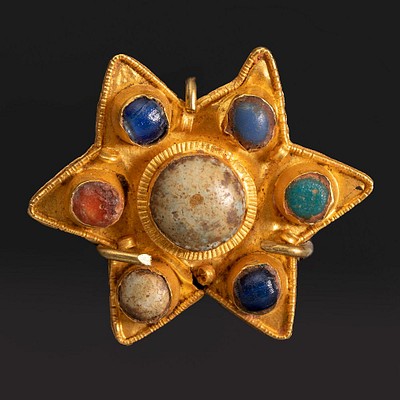Set of amulets and reliquaries; Hispano-Muslim art; 9th-15th century AD. Lead and amphora.
Lot 21
About Seller
Setdart Auction House
Carrer Aragó 346
Barcelona
Spain
Setdart Subastas was born in 2004 and is currently the first online art auction in Spain with solidity, prestige and reliability guaranteed by our more than 60,000 users. Setdart has a young, dynamic and enterprising team ready to successfully manage the purchase and sale of art works through custom...Read more
Estimate:
EUR€6,000 - EUR€6,500
$6,451.61 - $6,989.25
Absentee vs Live bid
Two ways to bid:
- Leave a max absentee bid and the platform will bid on your behalf up to your maximum bid during the live auction.
- Bid live during the auction and your bids will be submitted real-time to the auctioneer.
Bid Increments
| Price | Bid Increment |
|---|---|
| EUR€0 | EUR€10 |
| EUR€200 | EUR€25 |
| EUR€500 | EUR€50 |
| EUR€1,000 | EUR€100 |
| EUR€3,000 | EUR€200 |
| EUR€5,000 | EUR€500 |
| EUR€10,000 | EUR€1,000 |
| EUR€20,000 | EUR€2,000 |
| EUR€50,000 | EUR€5,000 |
About Auction
By Setdart Auction House
Dec 21, 2021
Set Reminder
2021-12-21 07:30:00
2021-12-21 07:30:00
America/New_York
Bidsquare
Bidsquare : Córdoba: 2,000 Years of Art
https://www.bidsquare.com/auctions/setdart-auction-house/c-rdoba-2-000-years-of-art-8049
Setdart Auction House sofia@setdart.com
Setdart Auction House sofia@setdart.com
- Lot Description
Set of amulets and reliquaries; Hispano-Muslim art; 9th-15th century AD. Lead and amphora. Measurements: 0,5 cm; (minor); 7,5 x 2,5 cm (major); 30 x 51 cm (support). Lot composed of 59 pieces, some of them reliquaries and others amulets. Some of the pieces that compose the set present inscriptions in kufic, or ornamental elements as for example the Star of David, or the Hand of Fatima. Many of the reliquaries are open so they do not keep anything inside. The realization of this type of religious objects, designed to house relics or to protect from the evil eye, was common since Roman times, highlighting both the crosses, as the so-called "testas", which, in the contemporary documentation to its realization, were very popular. They were used to contain relics. In spite of the fact that many of them adopted very diverse forms, all of them had the same devotional purpose, which sometimes went beyond fanaticism. It should be remembered, however, that at that time, practically any element that had been in contact with a saint or prophet or with his mortal remains (cloths, burial soil, etc.) was considered a sacred relic. This triggered a whole market for such objects. The best examples were made of precious metals, but specimens such as the present one were also highly valued, both for the container and, above all, for the content.
- Shipping Info
-
In-house shipping available. Please inquire at admin@setdart.com.
-
- Buyer's Premium



 EUR
EUR CAD
CAD AUD
AUD GBP
GBP MXN
MXN HKD
HKD CNY
CNY MYR
MYR SEK
SEK SGD
SGD CHF
CHF THB
THB














